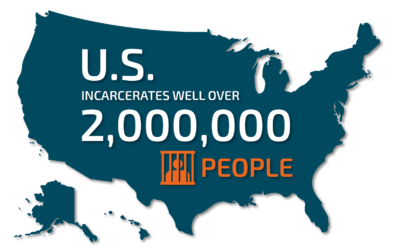
United States

The United States has the largest prison population in the world. Here are some facts:
- Though the U.S. holds only about five percent of the world’s population, it incarcerates well over 2,000,000 people, which is 22% of the world’s prisoners.
- The United States also has the highest rate of incarceration in the world, with 655 incarcerated per 100,000 of the population. (Next highest is Turkey, with 344 per 100,000)
- Incarceration levels are more extensive in the United States than in countries with larger populations. This means there are more prisoners in the U.S, than any other country.

It behooves citizens to ask; Is the high rate of incarceration a deterrent for crime? Does incarceration increase public safety? Not so much, according to The National Research Council stating “…the magnitude of the crime reduction remains highly uncertain and the evidence suggests it was unlikely to have been large.” In other words, while acknowledging that crime levels are lower, the National Research Council concluded that rising imprisonment plays a minimal role.
Jurisprudence, crime, criminal justice, penalties, and prison reform remain critical issues in the United States.
Crime Statistics in the United States
Crime statistics in the United States are monitored and documented by organizations such as the Bureau of Justice, the Federal Bureau of Investigation, and several federal and state organizations. Statistics are analyzed to determine the effectiveness of crime prevention tactics. This research also provides a deeper look into socioeconomic conditions within the population and their attendant relationship to crime stats.
- In 2019, there were an estimated 1,203,808 violent crimes. This number represents a slight decrease from the figures for 2018.
- In that same year, there were an estimated 6,925,677 property crimes. This annual figure is diminishing as well.
- Collectively, victims of property crimes in 2019 suffered about $15.8 billion in losses.
- Law enforcement agencies across the United States made about 10.1 million arrests in 2019 (excluding traffic violations).
- The arrest rate was about 156 per 100,000 residents, and the arrest rate for property crime was about 343 for every 100,000 residents.
The U.S. Criminal Justice System
The United States criminal justice system consists of three key components:
- Law enforcement agencies (primarily the police force and other specialist units),
- The court system (mainly prosecution and defense lawyers, judges, and jurors), and
- Detainment facilities (referring to prisons, jails, penitentiaries, and probation programs).
This system is not organized under one all-encompassing institution. There are law enforcement agencies, court systems, and detainment facilities at both the federal and state level. Although criminal law varies state to state and federally, most laws within the United States are modelled on interpretations of the U. S Constitution.
Penalties for Crimes Committed
The penalties for breaking laws in the United States are quite varied. Penalties for low-level offenses include:
- Fines,
- Community service,
- Educational programs, and
- Some jail time
For more severe offenses, penalties include:
- Several years of incarceration,
- Forced labor,
- Solitary confinement, and
- A lifetime of incarceration.
Though there is a global movement to condemn and outlaw the death penalty, the United States is one of the few remaining nations that still practices capital punishment.
Criminal justice reform, prison reform, and inmate programs are needed to improve both the system of incarceration and the recidivism of inmates.
U.S. Criminal Justice Reform
The goal of Criminal Justice reform is to correct perceived errors within the criminal justice system. This effort is manifested in several ways.
For example, much of the reform effort in the United States revolves around examining the laws used to incarcerate people in the first place. As mentioned earlier, much of U.S. law was written based on interpretations of the U.S. Constitution. But as times change, new information comes forward, there are new governing bodies and public opinion shifts. New interpretations of Constitutional law emerge, laws are revised, changed, or entirely rewritten. Because of ever-changing circumstances, laws need to be freshly examined in terms of fairness and effectiveness.
Justice reform also includes programs to facilitate a prisoner’s re-entry into society and recidivism reduction programs.
Therefore, it is prudent to continue to examine the efficacy and return on investment of the 80 billion spent annually to keep over two million people behind bars. No matter what side of the bars they are on, everyone in our country is affected in some way (even if through taxes) by this situation.
Perhaps these measured approaches can lead to better outcomes for offenders and society at large.
Finally, no matter how it manifests or what branch of the system it seeks to address, any criminal justice reform will have to follow a shared goal or objective: i.e., making criminal justice fairer and more effective.
Sources:
- https://www.prisonstudies.org/sites/default/files/resources/downloads/wppl_12.pdf
- https://www.fbi.gov/news/pressrel/press-releases/fbi-releases-2019-crime-statistics
- https://www.amnesty.org/en/latest/news/2020/04/death-penalty-in-2019-facts-and-figures/
- https://www.amnesty.org/en/what-we-do/death-penalty/
- https://www.sentencingproject.org/criminal-justice-facts/
- https://www.statista.com/statistics/300986/incarceration-rates-in-oecd-countries/




